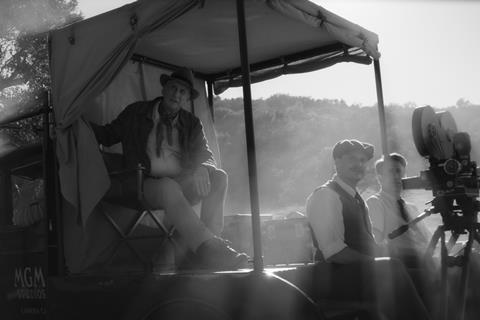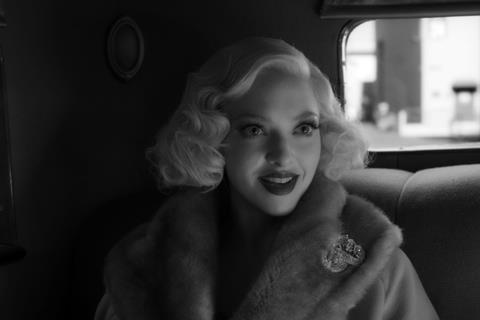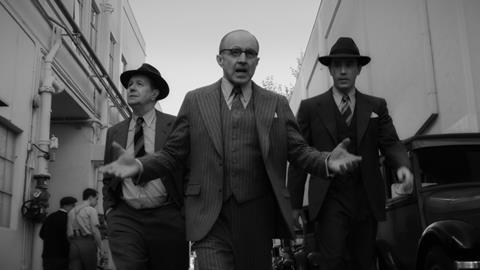The techniques behind Mank, David Fincher’s digitally dexterous emulation of Hollywood’s classic era, are revealed

David Fincher’s passion project about the Citizen Kane screenwriter Herman J. Mankiewicz looks, as intended, like a love letter to 1930s cinema. The filmmakers employ sophisticated digital techniques to pay homage to the cinematic bravura that helps Orson Welles’ masterpiece regularly top the list of all-time classics.
It’s a film the director originally intended as the follow-up to his 1997 thriller The Game, shortly after his father Howard, a journalist at LIFE magazine, wrote the script. For one reason and another, and reports suggest it was Fincher’s insistence on shooting in black and white, Mank was delayed until Netflix greenlit production late last year. Principal photography finished in February, just days before California went into lockdown.
Fincher of course kickstarted the streamer’s original content by masterminding House of Cards. He has subsequently made two series of serial killer investigation Mindhunter, all sixteen episodes shot by Erik Messerschmidt ASC who is Fincher’s collaborator here.
Mank follows the ‘scathing social critic and alcoholic’, played by Gary Oldman as he races to finish the Kane screenplay for Welles. It also stars Charles Dance as newspaper tycoon William Randolph Hearst and Amanda Seyfried as Heart’s girlfriend Marion Davies, satirized by Welles and Mankiewicz as Charles Foster Kane and mistress Susan Alexander. The connection with Hearst is strengthened by the fact that Mankiewicz was a frequent guest of Davies at Hearst’s fabulous California castle, dubbed Xanadu in Kane.
As a homage to WWII-era Hollywood the decision to emulate the look pioneered by cinematographers like Gregg Toland in digital format is a bold one.
“For this movie we wanted to shoot very deep focus photography for most of the film and then be very specific about where we used shallow focus,” says Messerschmidt. “Shooting on film would have significantly limited our creative choices, particularly with focus and depth of field.”
Aside from black and white, deep focus is the principal aesthetic in Mank. It’s a technique invented by landscape photographers, adopted by film directors in the 1920s, and popularised in Kane.
Erik Messerschmidt ASC: ‘we wanted to shoot very deep focus photography for most of the film’
Instead of using a shallow depth of field to create an impression of space within the picture, deep focus keeps everything in the frame in focus. In Citizen Kane, Toland often positions the camera at a low angle with even the ceilings in frame and used light, shadow and the set design of Perry Ferguson to imply depth.
Messerschmidt acknowledges that shooting black and white film can look “beautiful” and that it has lots of inherent qualities. “But you are stuck with those qualities making it difficult to deviate from them if they aren’t exactly what you’re after,” he says.

“David is interested in repeatability and consistency and unfortunately the photochemical process is, by nature, antithetical to that. There are a lot of variables to getting the image onto screen whether that’s the bath temperature, the composition of chemicals, the age of the film stock, the projection process. A lot of people see it as an advantage but we were not particularly interested in embracing the variables we could otherwise control or eliminate with the digital camera.”
It was obvious that Fincher would shoot on Red – the Red Ranger Helium Monochrome was the choice here – he hasn’t shot with other digital cameras since lensing The Curious Case of Benjamin Button in 2008.
Less clear cut was opting for a Red camera with a black and white sensor, but in tests Messerschmidt confirmed which way to go. Colour sensors employ Bayer filters to funnel either red, green or blue light onto each photosite, consequently blocking two-thirds of available light. Black and white, or monochrome, sensors on the other hand don’t need that filter which means that more detail and less noise will be captured at any camera setting.
“Capturing monochrome natively is better than shooting in colour and eliminating the saturation in post,” he reports. “Because there is no demosaic of the image, what you get is a pure, accurate black and white artistic image and significantly more speed out of the sensor.”
- Behind the scenes: Motherless Brooklyn
Filming noir
Messerschmidt was on location in South Africa shooting episodes of Ridley Scott’s HBO+ series Raised by Wolves when the call came.
“The opportunity to shoot black and white rarely comes along so I grabbed it with both hands,” he enthuses. “The more David talked through his vision, the more excited I became.”
Aside from a commercial spot, however, the DP hadn’t shot in the format since film school.
“Most people instinctually think of film noir when asked to imagine a black and white movie. Just as with colour film, there’s tremendous diversity in the styles and look of the noir genre let alone across the entire canon of black and white cinematography.”
Noir has its roots in German Expressionist cinema of the 1920s and influenced Welles and Toland in making Citizen Kane. Welles would accentuate the high contrast light and shade and deep depth of field in later definitively noir movies like Touch of Evil.

“My biggest fear was that I’d get drawn in by the desire to be dramatic and aggressive with light,” Messerschmidt reveals. “If a scene had some venetian blinds it was so tempting to put a light behind them. In Mank, we are emulating and paying respect to the cinema of the 1930s and ‘40s but we don’t want it to become a pastiche.”
Fincher and Messerschmidt reviewed a range of black and white cinema, including Wuthering Heights (1939) and Grapes of Wrath (1940), both lensed by Toland, classic noirs The Big Sleep (1946), The Big Combo (1955) and Casablanca (1942) as well as features from later periods like In Cold Blood (1967) and Billy Wilder’s The Apartment (1960).
“We also looked at modern movies like Manhattan (1979) which is more naturalistic in tone. We’d both pull scenes from different movies for reference, and went back and forth until we had nailed the look.”
Shooting 8K
Mank is recorded in 8K, giving the filmmakers the greatest possible latitude in the DI.
“I would prefer the optics to be the bottleneck in relation to the image and not the sharpness of the sensor or its resolution,” says Messerschmidt about 8K. “The highest resolution sensor is best for me because that’s where I start to see the optics fall apart. In that instance, I can make a more measured choice in terms of what I am trying to give the audience visually. When I’ve shot on a higher resolution sensor it has always led to a better image, in my opinion.”
It’s a format and workflow that Messerschmidt, Fincher and colourist Eric Weidt first used for series 2 of Mindhunter. “You can take 8K camera negative and transcode it for conform or editorial purposes in lower res and then go back and finish reading it. You can’t do that in [lower than 4K] capture,” says Messerschmidt.
Other subtle nods to the photochemical process include the deliberate addition of side-to-side wobbles caused during the optical process when the film frame passes through the sprockets of a projector. These are most pronounced in Mank during dissolves and title cards.
Erik Messerschmidt ASC: ‘capturing monochrome natively is better than shooting in colour and eliminating the saturation in post’
Messerschmidt gave himself a further challenge by deciding to shoot outdoors in broad daylight for one particular sequence set at night. Shooting day for night was a common technique in movies up until the light sensitivity of digital cameras made shooting in extreme low light conditions practical. The trick is to underexpose the scene – whilst shining enough light onto the faces of actors to sell the effect.
“If you just underexpose you invariably don’t have enough light on the actor’s face for it to look natural,” he says. “It’s easier to manage in close-ups than in wides, particularly when the actors are moving. We spent a lot of time in prep figuring out where the actors would be in relation to the sun. I remember waking up those mornings praying there would be sun. The scene wouldn’t work if it were overcast, but we were really fortunate mother nature cooperated.”
All of which begs the question, why this approach in the first place? Other night scenes in Mank are indeed shot night for night. In this instance, it suited the narrative. “Mank and Marion enjoy a platonic romance and in this scene she opens up to him about her relationship with Hearst,” Messerschmidt explains. “They’ve built this strong friendship and Fincher wanted the scene to have a bit of a magical quality to it. This is enhanced because we’re showing them walking among Heart’s zoo of elephants, giraffes and monkeys, all of which required some visual effects help.”
- Behind the scenes: The Man in the High Castle




























No comments yet